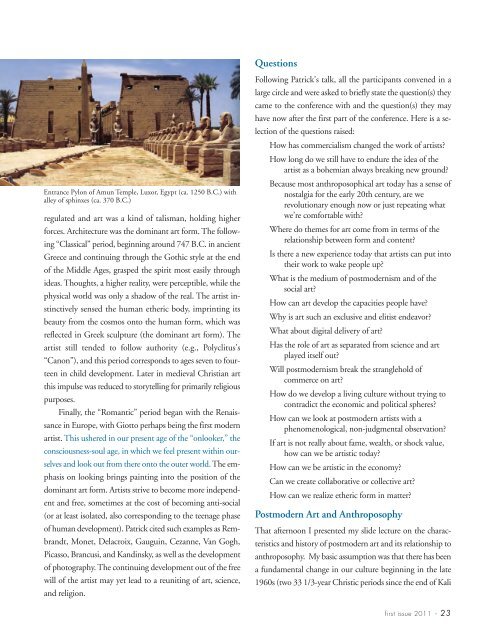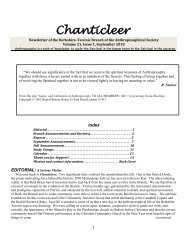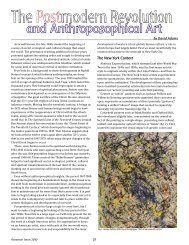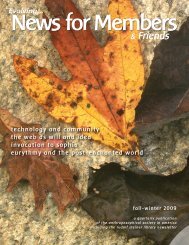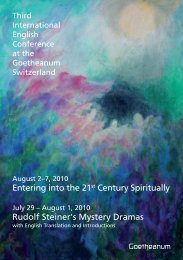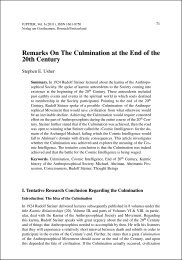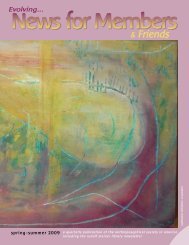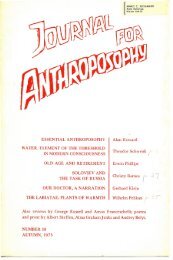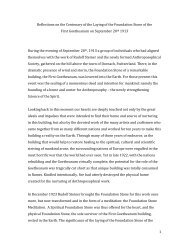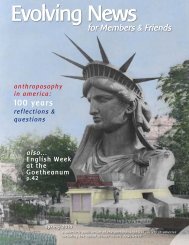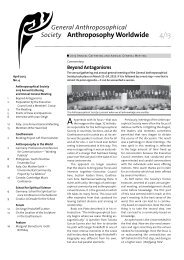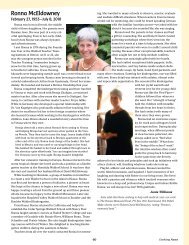Rudolf Steiner's Vision for the Future - Anthroposophical Society in ...
Rudolf Steiner's Vision for the Future - Anthroposophical Society in ...
Rudolf Steiner's Vision for the Future - Anthroposophical Society in ...
Create successful ePaper yourself
Turn your PDF publications into a flip-book with our unique Google optimized e-Paper software.
Entrance Pylon of Amun Temple, Luxor, Egypt (ca. 1250 B.C.) with<br />
alley of sph<strong>in</strong>xes (ca. 370 B.C.)<br />
regulated and art was a k<strong>in</strong>d of talisman, hold<strong>in</strong>g higher<br />
<strong>for</strong>ces. Architecture was <strong>the</strong> dom<strong>in</strong>ant art <strong>for</strong>m. The follow<strong>in</strong>g<br />
“Classical” period, beg<strong>in</strong>n<strong>in</strong>g around 747 B.C. <strong>in</strong> ancient<br />
Greece and cont<strong>in</strong>u<strong>in</strong>g through <strong>the</strong> Gothic style at <strong>the</strong> end<br />
of <strong>the</strong> Middle Ages, grasped <strong>the</strong> spirit most easily through<br />
ideas. Thoughts, a higher reality, were perceptible, while <strong>the</strong><br />
physical world was only a shadow of <strong>the</strong> real. The artist <strong>in</strong>st<strong>in</strong>ctively<br />
sensed <strong>the</strong> human e<strong>the</strong>ric body, impr<strong>in</strong>t<strong>in</strong>g its<br />
beauty from <strong>the</strong> cosmos onto <strong>the</strong> human <strong>for</strong>m, which was<br />
reflected <strong>in</strong> Greek sculpture (<strong>the</strong> dom<strong>in</strong>ant art <strong>for</strong>m). The<br />
artist still tended to follow authority (e.g., Polyclitus’s<br />
“Canon”), and this period corresponds to ages seven to fourteen<br />
<strong>in</strong> child development. Later <strong>in</strong> medieval Christian art<br />
this impulse was reduced to storytell<strong>in</strong>g <strong>for</strong> primarily religious<br />
purposes.<br />
F<strong>in</strong>ally, <strong>the</strong> “Romantic” period began with <strong>the</strong> Renaissance<br />
<strong>in</strong> Europe, with Giotto perhaps be<strong>in</strong>g <strong>the</strong> first modern<br />
artist. This ushered <strong>in</strong> our present age of <strong>the</strong> “onlooker,” <strong>the</strong><br />
consciousness-soul age, <strong>in</strong> which we feel present with<strong>in</strong> ourselves<br />
and look out from <strong>the</strong>re onto <strong>the</strong> outer world. The emphasis<br />
on look<strong>in</strong>g br<strong>in</strong>gs pa<strong>in</strong>t<strong>in</strong>g <strong>in</strong>to <strong>the</strong> position of <strong>the</strong><br />
dom<strong>in</strong>ant art <strong>for</strong>m. Artists strive to become more <strong>in</strong>dependent<br />
and free, sometimes at <strong>the</strong> cost of becom<strong>in</strong>g anti-social<br />
(or at least isolated, also correspond<strong>in</strong>g to <strong>the</strong> teenage phase<br />
of human development). Patrick cited such examples as Rembrandt,<br />
Monet, Delacroix, Gaugu<strong>in</strong>, Cezanne, Van Gogh,<br />
Picasso, Brancusi, and Kand<strong>in</strong>sky, as well as <strong>the</strong> development<br />
of photography. The cont<strong>in</strong>u<strong>in</strong>g development out of <strong>the</strong> free<br />
will of <strong>the</strong> artist may yet lead to a reunit<strong>in</strong>g of art, science,<br />
and religion.<br />
Questions<br />
Follow<strong>in</strong>g Patrick’s talk, all <strong>the</strong> participants convened <strong>in</strong> a<br />
large circle and were asked to briefly state <strong>the</strong> question(s) <strong>the</strong>y<br />
came to <strong>the</strong> conference with and <strong>the</strong> question(s) <strong>the</strong>y may<br />
have now after <strong>the</strong> first part of <strong>the</strong> conference. Here is a selection<br />
of <strong>the</strong> questions raised:<br />
How has commercialism changed <strong>the</strong> work of artists?<br />
How long do we still have to endure <strong>the</strong> idea of <strong>the</strong><br />
artist as a bohemian always break<strong>in</strong>g new ground?<br />
Because most anthroposophical art today has a sense of<br />
nostalgia <strong>for</strong> <strong>the</strong> early 20th century, are we<br />
revolutionary enough now or just repeat<strong>in</strong>g what<br />
we’re com<strong>for</strong>table with?<br />
Where do <strong>the</strong>mes <strong>for</strong> art come from <strong>in</strong> terms of <strong>the</strong><br />
relationship between <strong>for</strong>m and content?<br />
Is <strong>the</strong>re a new experience today that artists can put <strong>in</strong>to<br />
<strong>the</strong>ir work to wake people up?<br />
What is <strong>the</strong> medium of postmodernism and of <strong>the</strong><br />
social art?<br />
How can art develop <strong>the</strong> capacities people have?<br />
Why is art such an exclusive and elitist endeavor?<br />
What about digital delivery of art?<br />
Has <strong>the</strong> role of art as separated from science and art<br />
played itself out?<br />
Will postmodernism break <strong>the</strong> stranglehold of<br />
commerce on art?<br />
How do we develop a liv<strong>in</strong>g culture without try<strong>in</strong>g to<br />
contradict <strong>the</strong> economic and political spheres?<br />
How can we look at postmodern artists with a<br />
phenomenological, non-judgmental observation?<br />
If art is not really about fame, wealth, or shock value,<br />
how can we be artistic today?<br />
How can we be artistic <strong>in</strong> <strong>the</strong> economy?<br />
Can we create collaborative or collective art?<br />
How can we realize e<strong>the</strong>ric <strong>for</strong>m <strong>in</strong> matter?<br />
Postmodern Art and Anthroposophy<br />
That afternoon I presented my slide lecture on <strong>the</strong> characteristics<br />
and history of postmodern art and its relationship to<br />
anthroposophy. My basic assumption was that <strong>the</strong>re has been<br />
a fundamental change <strong>in</strong> our culture beg<strong>in</strong>n<strong>in</strong>g <strong>in</strong> <strong>the</strong> late<br />
1960s (two 33 1/3-year Christic periods s<strong>in</strong>ce <strong>the</strong> end of Kali<br />
first issue 2011 • 23


